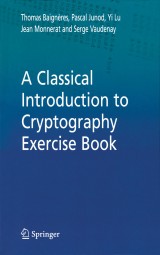Details

A Classical Introduction to Cryptography Exercise Book
|
46,00 € |
|
| Verlag: | Springer |
| Format: | |
| Veröffentl.: | 06.08.2007 |
| ISBN/EAN: | 9780387288352 |
| Sprache: | englisch |
| Anzahl Seiten: | 254 |
Dieses eBook enthält ein Wasserzeichen.
Beschreibungen
TO CRYPTOGRAPHY EXERCISE BOOK Thomas Baignkres EPFL, Switzerland Pascal Junod EPFL, Switzerland Yi Lu EPFL, Switzerland Jean Monnerat EPFL, Switzerland Serge Vaudenay EPFL, Switzerland Springer - Thomas Baignbres Pascal Junod EPFL - I&C - LASEC Lausanne, Switzerland Lausanne, Switzerland Yi Lu Jean Monnerat EPFL - I&C - LASEC EPFL-I&C-LASEC Lausanne, Switzerland Lausanne, Switzerland Serge Vaudenay Lausanne, Switzerland Library of Congress Cataloging-in-Publication Data A C.I.P. Catalogue record for this book is available from the Library of Congress. A CLASSICAL INTRODUCTION TO CRYPTOGRAPHY EXERCISE BOOK by Thomas Baignkres, Palcal Junod, Yi Lu, Jean Monnerat and Serge Vaudenay ISBN- 10: 0-387-27934-2 e-ISBN-10: 0-387-28835-X ISBN- 13: 978-0-387-27934-3 e-ISBN- 13: 978-0-387-28835-2 Printed on acid-free paper. O 2006 Springer Science+Business Media, Inc. All rights reserved. This work may not be translated or copied in whole or in part without the written permission of the publisher (Springer Science+Business Media, Inc., 233 Spring Street, New York, NY 10013, USA), except for brief excerpts in connection with reviews or scholarly analysis. Use in connection with any form of information storage and retrieval, electronic adaptation, computer software, or by similar or dissimilar methodology now know or hereafter developed is forbidden. The use in this publication of trade names, trademarks, service marks and similar terms, even if the are not identified as such, is not to be taken as an expression of opinion as to whether or not they are subject to proprietary rights. Printed in the United States of America.
Prehistory of Cryptography.- Conventional Cryptography.- Dedicated Conventional Cryptographic Primitives.- Conventional Security Analysis.- Security Protocols with Conventional Cryptography.- Algorithmic Algebra.- Algorithmic Number Theory.- Elements of Complexity Theory.- Public Key Cryptography.- Digital Signatures.- Cryptographic Protocols.- From Cryptography to Communication Security.
<P>This companion exercise and solution book to <EM>A Classical Introduction to Cryptography: Applications for Communications Security</EM> contains a carefully revised version of teaching material. It was used by the authors or given as examinations to undergraduate and graduate-level students of the Cryptography and Security Lecture at EPFL from 2000 to mid-2005. </P>
<P><STRONG>A Classical Introduction to Cryptography Exercise Book</STRONG> for <EM>A Classical Introduction to Cryptography: Applications for Communications Security</EM> covers a majority of the subjects that make up today's cryptology, such as symmetric or public-key cryptography, cryptographic protocols, design, cryptanalysis, and implementation of cryptosystems. Exercises do not require a large background in mathematics, since the most important notions are introduced and discussed in many of the exercises.</P>
<P>The authors expect the readers to be comfortable with basic facts of discrete probability theory, discrete mathematics, calculus, algebra, as well as computer science. Following the model of <EM>A Classical Introduction to Cryptography: Applications for Communications Security</EM>, exercises related to the more advanced parts of the textbook are marked with a star. </P>
<P><STRONG>A Classical Introduction to Cryptography Exercise Book</STRONG> for <EM>A Classical Introduction to Cryptography: Applications for Communications Security</EM> covers a majority of the subjects that make up today's cryptology, such as symmetric or public-key cryptography, cryptographic protocols, design, cryptanalysis, and implementation of cryptosystems. Exercises do not require a large background in mathematics, since the most important notions are introduced and discussed in many of the exercises.</P>
<P>The authors expect the readers to be comfortable with basic facts of discrete probability theory, discrete mathematics, calculus, algebra, as well as computer science. Following the model of <EM>A Classical Introduction to Cryptography: Applications for Communications Security</EM>, exercises related to the more advanced parts of the textbook are marked with a star. </P>
Derived from teaching material and examinations given by the authors at the Swiss Federal Institute of Technologies (EPFL), Switzerland Topics parallel those in the textbook Serge Vaudenay is head of the Security and Cryptography Laboratory (LASEC) at EPFL Includes supplementary material: sn.pub/extras
<P>This is a companion exercise and solution book to <STRONG>A Classical Introduction to Cryptography: Applications for Communications Security</STRONG> (0-387-25464-1). Coverage includes symmetric or public-key cryptography, cryptographic protocols, design, cryptanalysis, and implementation of cryptosystems. Readers should be comfortable with basic facts of discrete probability theory, discrete mathematics, calculus, algebra, and computer science. However, the exercises do not require an extensive background in mathematics, since the most important notions are introduced and discussed in many of them. Exercises related to the more advanced parts of the textbook are marked with a star.</P>
Diese Produkte könnten Sie auch interessieren:

Automatización Eficiente. Transformando la gestión de datos por medio de Microsoft Access

von: Damir-Nester Saedeq

13,99 €















